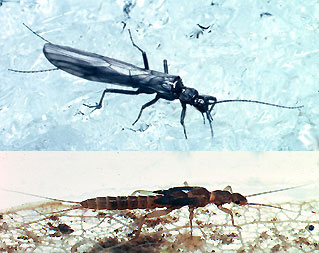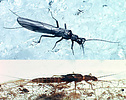Capniidae
Winter Stoneflies
C. Riley Nelson


This tree diagram shows the relationships between several groups of organisms.
The root of the current tree connects the organisms featured in this tree to their containing group and the rest of the Tree of Life. The basal branching point in the tree represents the ancestor of the other groups in the tree. This ancestor diversified over time into several descendent subgroups, which are represented as internal nodes and terminal taxa to the right.

You can click on the root to travel down the Tree of Life all the way to the root of all Life, and you can click on the names of descendent subgroups to travel up the Tree of Life all the way to individual species.
For more information on ToL tree formatting, please see Interpreting the Tree or Classification. To learn more about phylogenetic trees, please visit our Phylogenetic Biology pages.
close boxIntroduction
Capniidae is one of the largest families of Plecoptera with approximately 300 species divided between the nearctic, palearctic, and oriental regions. The nymphs are small, but long and slender. They are easily confused with those of Leuctridae, but generally have a groove in the side of the abdomen which extends from segment one to segment nine. In leuctrids this "fold" is not nearly as apparent.
The adults emerge during the coldest parts of the winter and are regularly seen walking on snow. In general, capniids are small stoneflies, most about 7 mm in length, although different species might range from 4 mm to more than 25 mm.
The nymphs inhabit the hyporheic zone, that is to say the zone of flow beneath the rocks and gravel on the bottom of streams and rivers. The nymphs come close to the substrate surface immediately prior to emergence. As such the nymphs are not always encountered in standard benthic samples, despite their numeric (and presumably ecological) importance.
Capniids have many narrowly endemic species, perhaps due to their narrow tolerances for cold environments which trap them in streams on mountain tops or perhaps due to the frequency of winglessness in the group. In fact these two reasons for endemism are probably interelated. Because of such rampant endemism the capniids are very useful in tracking the geological and evolutionary history of an area using such ideas as expressed by vicariance biogeographers.
Characteristics
Zwick (1973) lists the synapomorphies of Capniidae as: 1, cubital crossveins reduced, one or none left; 2, inner lobes of paraprocts fused to form a partially open tube, ventrally closed by outer lobes of paraprocts (this structure is called the fusion plate).
List of Genera
- Allocapnia
- Allocapniella
- Baikaloperla
- Capnia
- Capniella
- Capnioneura
- Capnopsis
- Capnura
- Eocapnia
- Eucapnopsis
- Isocapnia
- Mesocapnia
- Nemocapnia
- Paracapnia
- Takagripopteryx
- Utacapnia
Discussion of Phylogenetic Relationships
Little formal work has been done regarding the phylogeny of the genera in Capniidae. The tree I produce above reflects the phylogeny given for some genera in Ross and Ricker (1971) and my own unpublished studies. I have not looked closely at the taxa marked incertae sedis but hope to do so soon. Note that the genus Capnia is clearly paraphyletic. Adjustment of the taxonomy, either the naming of monophyletic clades of Capnia as new genera or sinking of many genera to yield a monophyletic Capnia needs to occur. I have done initial work placing some of the groups of Capnia into a phylogenetic system, I present this as an alternative view with groups labeled.
Ross and Ricker (1971) proposed that Allocapnia is the sister clade to the Capnia vidua group from the Palearctic. Unfortunately their recognition of Allocapnia as a genus rendered Capnia paraphyletic. They justified this recognition by saying,
"Despite its phylogenetic position as a branch of Capnia, we believe that Allocapnia should be designated as a separate genus because of the many distinctive features that have evolved. This designation of Allocapnia as a separate genus without treating other branches of Capnia in a like manner is an example of paraphyletic classification, strongly criticized by some (Hennig 1966). There are, however, many well-known examples of it in classification; for example, the recognition of Mammalia, Aves, and Reptilia as separate classes. There is no doubt that paraphyletic classification is a convenience that will continue to have frequent use."
I do not doubt, much, the monophyly of Allocapnia. With this assumption of monophyly comes the need for the treatment of "Capnia" such that named monophyletic groups can be erected from the rubble and paraphyletic groups eliminated.
References
Nelson, C. H. 1984. Numerical cladistic analysis of phylogenetic relationships in Plecoptera. Ann. Entomol. Soc. Amer. 77: 466-473.
Ross, H. H. & W. E. Ricker. 1971. The classification, evolution, and dispersal of the winter stonefly genus Allocapnia. Illinois Biological Monographs 45: 1-166.
Zwick, P. 1973. Insecta: Plecoptera. Phylogenetisches System und Katalog. Das Tierreich 94. Walter de Gruyter and Co., Berlin. 465 pp.
Title Illustrations

| Scientific Name | Capnia gracilaria, Capnia sp. |
|---|---|
| Location | Colorado |
| Copyright |
© 1996
C. Riley Nelson

|
About This Page
C. Riley Nelson

Brigham Young University, Provo, Utah, USA
Page copyright © 1996 C. Riley Nelson
All Rights Reserved.
Citing this page:
Nelson, C. Riley. 1996. Capniidae. Winter Stoneflies. Version 01 January 1996 (under construction). http://tolweb.org/Capniidae/13943/1996.01.01 in The Tree of Life Web Project, http://tolweb.org/







 Go to quick links
Go to quick search
Go to navigation for this section of the ToL site
Go to detailed links for the ToL site
Go to quick links
Go to quick search
Go to navigation for this section of the ToL site
Go to detailed links for the ToL site